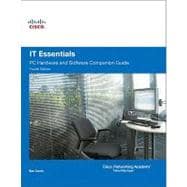The only Cisco authorized textbook for the revised IT Essentials: PC Hardware and Software course (v4.1), from the Cisco Networking Academy Companion Guide format complements the online curriculum with added insight and instruction from Academy instructors. The course provides an introduction to computer components, laptops and portable devices, wireless connectivity, security and safety, environmental concerns, and diagnostic tools.
A portable reference that supports all the topics in the new course, aligning 1:1 with course modules
Features improved readability, enhanced topic explanations, real-world examples, and all new graphical presentations
Aligned to new A+ objectives
The IT Essentials: PC Hardware and Software Companion Guide 4/e supplements and complements the version 4.1 online curriculum offered by the Cisco Networking Academy.
The Companion Guide is designed as the textbook for the Networking Academy course, offering you a portable desk reference of the course content to use anytime anywhere as a study aid. The chapter content aligns 1:1 to the online course module topics, but does not merely mimic the content word-for-word.
The authors present the course material in the Companion Guide in a comprehensive manner, providing their own examples where necessary to augment your understanding of the course material.
This book will have the CompTIA A+ seal of approval. The book focuses on the following elements to support the online curriculum: " Chapter Objectives are stated as questions at beginning of each chapter "
Key terms listed in the Chapter openers "
Enhanced readability for younger student comprehension "How To Feature provides step-by-step tasks for common activities"
Key concept recaps, Check Your Understanding Questions, and next chapter previews are in a concise summary at the end of each chapter








